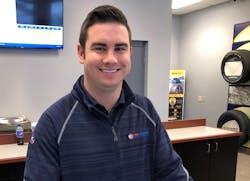Tire dealership adoption of digital tread depth scanners and automated tire installation machines will depend on shop space, return on investment and other factors, according to dealers who recently spoke with MTD.
TJ White, who manages one of six Tire Source stores in the Akron, Ohio, area, says space limitations at the dealership’s outlets are a barrier to the installation of drive-over tread depth readers.
“We would need one (drive-over reader) in each bay,” he says. “But the footprint at five of our stores is just not big enough.”
Hand-held tread depth scanners could be a more appealing solution, he notes. Traditional tread depth gauges “aren’t always perfect and there’s also a lot of room for human error. And with some of the wheel wells on cars, it’s harder and harder to use a gauge when the vehicle is in the parking lot.”
For optimal efficiency, he believes hand-held, digital tread depth scanners need to be integrated with point-of-sale systems. “If it’s not integrated and doesn’t auto-send to the point-of-sale system or invoice, it really is almost the same thing as taking a measurement with a traditional gauge.”
When it comes to tread depth scanning and even tire/wheel installation, “I do think that robots and automation are definitely coming.” But no machine can fully take the place of an experienced technician, he says.
“There are so many variables when it comes to installing tires. Is the tire directional? Is there corrosion on the wheel? Will the tire pressure monitoring system need to be rebuilt?”
Ari Thielman, general manager of G.T. Silver City Tire Co. Inc. in Meriden, Conn., is familiar with new tread depth measurement tools and technologies. “We are currently using the Autel MaxiTPMS TBE200.”
He says the product “gives you the ability to take pictures, take accurate tread depth (measurements) and upload or send information to the customer.”
Thielman sees the value in both drive-over readers and hand-held scanners. The latter devices “not only look professional. They also give a more accurate read-out” than technicians filling out traditional inspection sheets.
That said, Thielman doesn’t think automated devices will completely replace technicians. “A technician brings people skills and the ability to explain to the customer” what a service condition means.
Ryan Jennings, manager of Mark’s Tire Service in San Luis Obispo, Calif., also is familiar with automated tread depth scanning devices. But he isn’t sold on them yet.
“It would not make financial sense, at least in my opinion, to purchase an automated tread depth reader when a technician can walk out and do the same job with a (traditional) gauge.”
However, he does see “the practicality of an automated reader (making) recommendations to a technician on how to rotate tires based on vehicle year, make and model.
“Do I think humans, at some point, will be phased out of the service bay? Yes. Do I think it’s right around the corner? No. I think there is a lot of proving that needs to be done before I would invest in an automated service bay.”
Joe Hershberger, CEO of Joe’s Tire in Barnesville, Ohio, has reviewed automated tread depth scanners “at shows and I have considered them for our shops.”
They have to add value to the customer experience, he adds.
Three of Hershberger’s stores are located in Ohio. One is located in West Virginia. All are in small towns.
“I do think that tire dealers in cities (who are) servicing higher-end vehicles would benefit a lot from these units. They will help set a dealer apart from others, look more professional and (would be good) for upselling.
“I am looking forward to a time (when) we have more technology in our process,” reveals Hershberger. “Customers picking their tires and add-on services and scheduling their appointments should be able to be done at a kiosk in the store.”
But other functions will remain the domain of human beings, he says. “We don’t believe these tools will replace human technicians,” adds Mitch Bruneel, vice president of Bruneel Point S Tire & Auto Service, which is based in Boise, Idaho, and has 12 locations.
“Our stance is that tools are necessary to make us more efficient and accurate, but we will always need well-trained people to perform the day-to-day functions.”
Will there eventually be a place for automated systems and devices? Bruneel thinks so. “But we don’t know where that falls for us because we have not invested in them as of yet.”
About the Author
Mike Manges
Editor
Mike Manges is Modern Tire Dealer’s editor. A 28-year tire industry veteran, he is a three-time International Automotive Media Association Award winner, holds a Gold Award from the Association of Automotive Publication Editors and was named a finalist for the prestigious Jesse H. Neal Award, the Pulitzer Prize of business-to-business media, in 2024. He also was named Endeavor Business Media's Editor of the Year in 2024. Mike has traveled the world in pursuit of stories that will help independent tire dealers move their businesses forward. Before rejoining MTD in 2019, he held corporate communications positions at two Fortune 500 companies and served as MTD’s senior editor from 2000 to 2010.

